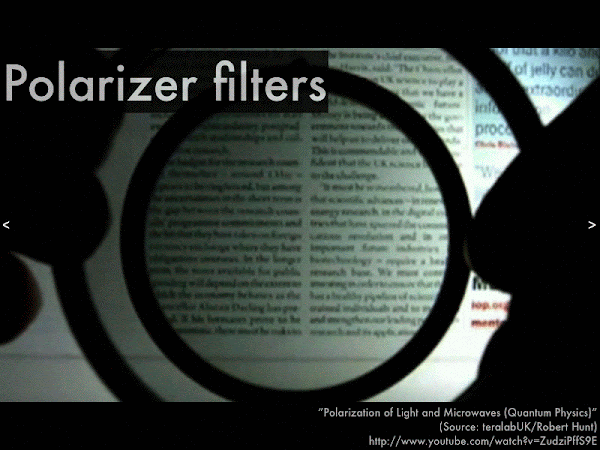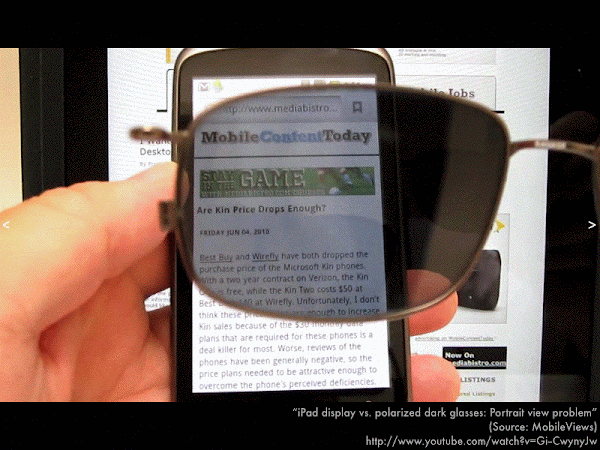Cuesta College, San Luis Obispo, CA
Students have a weekly online reading assignment (hosted by SurveyMonkey.com), where they answer questions based on reading their textbook, material covered in previous lectures, opinion questions, and/or asking (anonymous) questions or making (anonymous) comments. Full credit is given for completing the online reading assignment before next week's lecture, regardless if whether their answers are correct/incorrect. Selected results/questions/comments are addressed by the instructor at the start of the following lecture.
The following questions were asked on re-reading textbook chapters and reviewing presentations on polarization.

Selected/edited responses are given below.
Describe what you understand from the assigned textbook reading or presentation preview. Your description (2-3 sentences) should specifically demonstrate your level of understanding.
"Polarizers act like a picket fence or a filtering grate for light, filtering out waves with polarizations at 90° to their axis of transmission."
"I don't understand anything on the reading! The concepts are hard for me to understand! This is my least favorite thing thus far."
"Electromagnetic waves can be either unpolarized (particles moving in random vibrations), or polarized (particles oscillating in single back-and forth motions). Radio waves from antennae are polarized transverse waves; the orientation of the antennae (horizontal or vertical) determine how these waves are transmitted and received. Light can be polarized using filters that limit/eliminate light with a certain polarization, i.e., polarized sunglasses that block out horizontally polarized light to cut glare. This filtering cuts the wave amplitude, or light intensity, by 50%. If two filters are stacked and are perpendicular to each other, the light source will not be visible, as 100% of the light will be filtered."
"Malus' Law is used to calculate the amount of polarized or unpolarized light that is transmitted through a polarizer. If vertically polarized light passes through a polarizer with a transmission axis of 30°, then the amount of light transmitted is the square of the cosine of 30°."
"I understand just enough to be really confused. Unpolarized light comes from the sun, lights bulbs, etc., and contains every possible sideways oscillation. When light is polarized only one direction (vertical, horizontal, etc.) of light passes through the polarizer, while the others are absorbed. The polarized light will have one-half the intensity of the unpolarized light."
Describe what you found confusing from the assigned textbook reading or presentation preview. Your description (2-3 sentences) should specifically identify the concept(s) that you do not understand.
"I believe that I have this down."
"I find it all confusing. Malus' law as an equation I could plug-and-chug, but conceptually, no chance."
"More applications never hurts."
"I don't understand the way the signal transmits from an antenna. It's basic, but not basic."
"I'm not quite sure what the 'fencepost model' is."
"All visible light begins unpolarized?"
"Polarization percentages?"
"This stuff freaks me out. I don't get how unpolarized light can contain every possible sideways oscillation, or how when that light is polarized into one direction it contains one-half of the original intensity (it's one part of an infinity of parts!), or how light that is traveling in 'one direction' can have both horizontal and vertical components. This is Schrodinger's cat stuff."

0%. ******* [7] 50%. ************************** [26] 100%. **** [4] (Unsure/guessing/lost/help!) ** [2]
Unpolarized light shines through two ideal polarizing sheets, that have their transmission axes aligned at right angles to each other. How much of the original intensity is transmitted through these two sheets?
0%. ************************ [24] 50%. ****** [6] 100%. ** [2] (Unsure/guessing/lost/help!) ******* [7]

When the light that passed through the first polarizer is now completely blocked by the second polarizer, the transmission axis of the second polarizer is:
horizontal. *** [3] vertical. ************************* [25] diagonal, upper left to lower right. **** [4] diagonal, lower left to upper right. ** [2] (Unsure/guessing/lost/help!) ***** [5]

Light from the screen of the iPad (in portrait mode) is:
horizontally polarized. ************************ [24] vertically polarized. ********** [10] diagonally (upper left to lower right) polarized. * [1] diagonally (lower left to upper right) polarized. * [1] unpolarized. [0] (Unsure/guessing/lost/help!) *** [3]

Light from the screen of the Nexus 4 is:
horizontally polarized. ****** [6] vertically polarized. ****** [6] diagonally (upper left to lower right) polarized. ******* [7] diagonally (lower left to upper right) polarized. ************* [13] unpolarized. *** [3] (Unsure/guessing/lost/help!) **** [4]
Ask the instructor an anonymous question, or make a comment. Selected questions/comments may be discussed in class.
"I am so burnt out from life that I haven't been able to engage in any of your lectures and I need to change that! #nopainnogain" (#squadgoals)
"I need to quit my job so I have more time for school, but there's nobody to replace me because everyone else at my position already quit." (#toolegittoquit)
"Help :O"
"What happens to radio waves in space? Do they orbit around Earth or go in a straight line?" (Some radio wavelengths get absorbed or internally reflected off of the ionosphere (a layer of charged particles in the upper atmosphere), but other radio wavelengths go through into space traveling at the speed of light, decreasing in intensity as they spread outwards in all directions. Some of the signals have already traveled to nearby stars.)
No comments:
Post a Comment